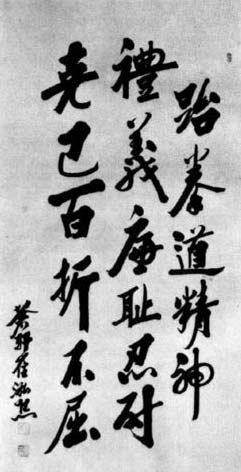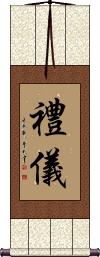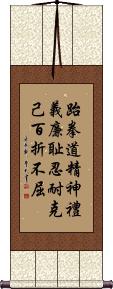Many custom options...
And formats...

Propriety in Chinese / Japanese...
Buy a Propriety calligraphy wall scroll here!
Personalize your custom “Propriety” project by clicking the button next to your favorite “Propriety” title below...
Courtesy / Etiquette
In Chinese, old Korean Hanja, and old Japanese Kanji, 禮儀 means “etiquette” or “courtesy.”
You'll also find a Japanese entry on our website, which uses a modern/simplified first Kanji. The characters shown here compose the best choice if your audience is Chinese or Korean - but also acceptable if you want an ancient-style Japanese scroll (in modern Japanese, it has the same pronunciation, but is written 礼儀).
Note: This can also be translated as propriety, decorum, or formality.
Respect
Politeness, Gratitude and Propriety
礼 is one of the five tenets of Confucius.
Beyond respect, 礼 can also be translated as propriety, good manners, politeness, rite, worship, or an expression of gratitude.
We show respect by speaking and acting with courtesy. We treat others with dignity and honor the rules of our family, school, and nation. Respect yourself, and others will respect you.
 Please note that Japanese use this simplified 礼 version of the original 禮 character for respect. 礼 also happens to be the same simplification used in mainland China. While 禮 is the traditional and original version, 礼 has been used as a shorthand version for many centuries. Click on the big 禮 character to the right if you want the Traditional Chinese and older Japanese versions.
Please note that Japanese use this simplified 礼 version of the original 禮 character for respect. 礼 also happens to be the same simplification used in mainland China. While 禮 is the traditional and original version, 礼 has been used as a shorthand version for many centuries. Click on the big 禮 character to the right if you want the Traditional Chinese and older Japanese versions.
This is also a virtue of the Samurai Warrior
See our page with just Code of the Samurai / Bushido here
See Also: Confucius
Taekwondo Tenets / Spirit of Taekwon-do
跆拳道精神禮義廉耻忍耐克己百折不屈 is General Choi's writing that is often called “The Tenets of Taekwon-do.”

The actual title would be translated as “Taekwondo Spirit” or “The Spirit of Taekwondo.” It was originally written in Korean Hanja (Chinese characters used in Korea for about 1600 years).
General Choi's original calligraphy is shown to the right. Your custom calligraphy will be unique, and not an exact match, as each calligrapher has their own style.In modern times, the common form of written Korean is Hangul (a phonetic character set). The table below shows the text in Hangul and Hanja along with a pronunciation guide and a brief English translation:
| Traditional Korean Hanja | Modern Korean Hangul | Pronunciation | English |
| 跆拳道精神 | 태권도정신 | tae gweon do jeong sin | Taekwondo Spirit |
| 禮儀 | 예의 | ye yi | Courtesy / Etiquette / Propriety / Decorum / Formality |
| 廉耻 | 염치 | yeom ci | Integrity / Sense of Honor |
| 忍耐 | 인내 | in nae | Patience / Perseverance / Endurance |
| 克己 | 극기 | geug gi | Self-Control / Self-Denial / Self-Abnegation |
| 百折不屈 | 백절불굴 | baeg jeor bur gur | Indomitable Spirit (Undaunted even after repeated attacks from the opponent) |
| Note that the pronunciation is the official version now used in South Korea. However, it is different than what you may be used to. For instance, “Taekwon-do” is “tae gweon do.” This new romanization is supposed to be closer to actual Korean pronunciation. | |||
This in-stock artwork might be what you are looking for, and ships right away...
These search terms might be related to Propriety:
Courtesy / Politeness
Humble / Modesty / Humility
Modesty
Sense of Shame / Sense of Honor / Integrity / Modesty (Korean)
Simplicity / Modesty
Not the results for propriety that you were looking for?
Below are some entries from our dictionary that may match your propriety search...
| Characters If shown, 2nd row is Simp. Chinese |
Pronunciation Romanization |
Simple Dictionary Definition |
禮 礼 see styles |
lǐ li3 li rai らい |
gift; rite; ceremony; CL:份[fen4]; propriety; etiquette; courtesy (personal name) Rai Worship, offerings, rites; ritual, ceremonial, decorum, courtesy, etiquette. |
事理 see styles |
shì lǐ shi4 li3 shih li jiri じり |
reason; logic reason; facts; propriety; sense Practice and theory; phenomenon and noumenon, activity and principle, or the absolute; phenomena ever change, the underlying principle, being absolute, neither changes nor acts, it is the 眞如 q. v. also v. 理. For 事理法界 (事理無礙法界) v. 四法界. |
五常 see styles |
wǔ cháng wu3 chang2 wu ch`ang wu chang gojou / gojo ごじょう |
the five cardinal virtues in traditional Chinese ethics: benevolence 仁[ren2], justice 義|义[yi4], propriety 禮|礼[li3], wisdom 智[zhi4] and honor 信[xin4]; alternative term for 五倫|五伦[wu3lun2], the five cardinal relationships; alternative term for 五行[wu3xing2], the five elements the five cardinal Confucian virtues (justice, politeness, wisdom, fidelity and benevolence); (place-name) Gojō five constant [virtues] |
作法 see styles |
zuò fǎ zuo4 fa3 tso fa sahou(p); sakuhou / saho(p); sakuho さほう(P); さくほう |
course of action; method of doing something; practice; modus operandi (1) (さほう only) manners; etiquette; propriety; (2) manner of production (esp. of prose, poetry, etc.); way of making Karma, which results from action, i.e. the "deeds" of body or mouth; to perform ceremonies. |
分寸 see styles |
fēn cun fen1 cun5 fen ts`un fen tsun bunzu ぶんず |
propriety; appropriate behavior; proper speech or action; within the norms (place-name) Bunzu |
口德 see styles |
kǒu dé kou3 de2 k`ou te kou te |
propriety in speech |
可否 see styles |
kě fǒu ke3 fou3 k`o fou ko fou kahi かひ |
is it possible or not? (noun - becomes adjective with の) (1) propriety; right and wrong; advisability; possibility; (noun - becomes adjective with の) (2) pro and con; ayes and noes |
四德 see styles |
sì dé si4 de2 ssu te shitoku |
four Confucian injunctions 孝悌忠信 (for men), namely: piety 孝 to one's parents, respect 悌 to one's older brother, loyalty 忠 to one's monarch, faith 信 to one's male friends; the four Confucian virtues for women of morality 德[de2], physical charm 容, propriety in speech 言 and efficiency in needlework 功 The four nirvana virtues, or values, according to the Mahāyāna Nirvana Sutra: (1) 常德 permanence or eternity; (2) 樂德 joy; (3) 我德 personality or the soul; (4) 淨德 purity. These four important terms, while denied in the lower realms, are affirmed by the sutra in the transcendental, or nirvana-realm. |
四維 四维 see styles |
sì wéi si4 wei2 ssu wei shii; shiyui(ok) / shi; shiyui(ok) しい; しゆい(ok) |
the four social bonds: propriety, justice, integrity and honor; see 禮義廉恥|礼义廉耻[li3 yi4 lian2 chi3]; the four directions; the four limbs (Chinese medicine); four-dimensional (1) (See 四隅・2) four ordinal directions; (2) (しい only) (from Guanzi) four cardinal principles of the state (propriety, justice, integrity, sense of shame); (surname) Yotsui The four half points of the compass, N. E., N. W., S. E., S. W. |
官箴 see styles |
guān zhēn guan1 zhen1 kuan chen |
rules of propriety for government officials |
尺寸 see styles |
chǐ cun chi3 cun5 ch`ih ts`un chih tsun shakusun; sekisun しゃくすん; せきすん |
size; dimensions; measurements (esp. of clothes); (coll.) propriety (something) tiny; trifle |
当否 see styles |
touhi / tohi とうひ |
propriety; right or wrong; justice |
復禮 复礼 see styles |
fù lǐ fu4 li3 fu li fukurei |
returning propriety |
礼節 see styles |
reisetsu / resetsu れいせつ |
decorum; propriety; politeness |
端嚴 端严 see styles |
duān yán duan1 yan2 tuan yen tangon |
In strict propriety. |
越軌 越轨 see styles |
yuè guǐ yue4 gui3 yüeh kuei |
to run off the track; to step out of line; to overstep the bounds of propriety |
進退 进退 see styles |
jìn tuì jin4 tui4 chin t`ui chin tui shintai(p); shindai(ok) しんたい(P); しんだい(ok) |
to advance or retreat; knowing when to come and when to leave; a sense of propriety (noun/participle) (1) advance or retreat; moving forwards or backwards; movement; (noun/participle) (2) course of action; behaviour; conduct; attitude; (noun/participle) (3) remaining in one's post or resigning; staying or leaving advancing and regressing; vacillation |
適否 see styles |
tekihi てきひ |
propriety; fitness; aptitude |
頃合 see styles |
koroai ころあい |
(noun - becomes adjective with の) (1) suitable time; good time; (2) propriety; moderation |
體統 体统 see styles |
tǐ tǒng ti3 tong3 t`i t`ung ti tung |
decorum; propriety; arrangement or form (of piece of writing) |
高低 see styles |
gāo dī gao1 di1 kao ti koutei(p); takahiku / kote(p); takahiku こうてい(P); たかひく |
height; level; (music) pitch; relative superiority; propriety; discretion (usu. in the negative, e.g. 不知高低[bu4zhi1 gao1di1]); no matter what; just; simply (will not ..., must ... etc); at long last (noun/participle) high and low; rise and fall |
主人顔 see styles |
shujingao しゅじんがお |
propriety air |
失體統 失体统 see styles |
shī tǐ tǒng shi1 ti3 tong3 shih t`i t`ung shih ti tung |
lacking in propriety; bad form |
如法衣 see styles |
rú fǎ yī ru2 fa3 yi1 ju fa i nyohō e |
to wear clothes according to ritual or the propriety of the situation in Buddhism |
妥当性 see styles |
datousei / datose だとうせい |
validity; verification; propriety |
客氣話 客气话 see styles |
kè qi huà ke4 qi5 hua4 k`o ch`i hua ko chi hua |
words of politeness; politesse; decorous talking; talk with propriety |
正当性 see styles |
seitousei / setose せいとうせい |
(noun - becomes adjective with の) lawfulness; propriety; reasonableness; appropriateness; legality; legitimacy; justifiability; validity |
頃合い see styles |
koroai ころあい |
(noun - becomes adjective with の) (1) suitable time; good time; (2) propriety; moderation |
三從四德 三从四德 see styles |
sān cóng sì dé san1 cong2 si4 de2 san ts`ung ssu te san tsung ssu te |
Confucian moral injunctions for women, namely: obey in turn three men father, husband and son, plus the four virtues of morality 德[de2], physical charm 容, propriety in speech 言 and efficiency in needlework 功 |
三綱五常 三纲五常 see styles |
sān gāng wǔ cháng san1 gang1 wu3 chang2 san kang wu ch`ang san kang wu chang |
three principles and five virtues (idiom); the three rules (ruler guides subject, father guides son and husband guides wife) and five constant virtues of Confucianism (benevolence 仁, righteousness 義|义, propriety 禮|礼, wisdom 智 and fidelity 信) |
Click here for more propriety results from our dictionary
The following table may be helpful for those studying Chinese or Japanese...
| Title | Characters | Romaji (Romanized Japanese) | Various forms of Romanized Chinese | |
| Courtesy Etiquette | 禮儀 礼仪 | lǐ yì / li3 yi4 / li yi / liyi | li i / lii | |
| Respect | 禮 礼 | rei | lǐ / li3 / li | |
| Taekwondo Tenets Spirit of Taekwon-do | 跆拳道精神禮義廉耻忍耐克己百折不屈 跆拳道精神礼义廉耻忍耐克己百折不屈 | tái quán dào jīng shén lǐ yì lián chǐ rěn nài kè jǐ bǎi zhé bù qū tai2 quan2 dao4 jing1 shen2 li3 yi4 lian2 chi3 ren3 nai4 ke4 ji3 bai3 zhe2 bu4 qu1 tai quan dao jing shen li yi lian chi ren nai ke ji bai zhe bu qu | t`ai ch`üan tao ching shen li i lien ch`ih jen nai k`o chi pai che pu ch`ü tai chüan tao ching shen li i lien chih jen nai ko chi pai che pu chü |
|
| In some entries above you will see that characters have different versions above and below a line. In these cases, the characters above the line are Traditional Chinese, while the ones below are Simplified Chinese. | ||||
Successful Chinese Character and Japanese Kanji calligraphy searches within the last few hours...







